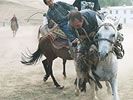Eye For Film >> Movies >> 37 Uses For A Dead Sheep (2006) Film Review
The history of the Pamir Kirghiz, a little known tribe from that vast mountain mass, which in 1895 the British and Russians carved up into what became known as Afghanistan, is one of tenacity and survival against deprivation and persecution.
Tribe is too native a word to describe these gracious and ingenious people. Not only do they have 37 uses for a dead sheep, but yoghurt has a multitude of recipes and properties, including, in one fabled incident, as an antidote to poison.

Once their territory was redrawn on the map after an international agreement, of which they had no knowledge, "the Russians tried to destroy our culture". They did more than that. "They came and took our land and killed us." Running battles continued for years until the Pamir fled to China where things were even worse. The Communists confiscated their belongings, including their animals, gave them a handful of flour a day and made them work from dawn until dusk for no wages. Many died of starvation.
They escaped back to the mountains of Afghanistan, where for 20 whole days there was no frost. During the rest of the year "hands froze while milking the yak." Water froze in the buckets on the way from the well. There were no doctors, no medicine and men pulled their own teeth. Others became addicted to opium.
When the Russians were about to invade the country, they left for Pakistan - 1,300 people on the long march, "women walking with no shoes" and 30,000 animals - where they spent four years in a refugee camp, lost all their animals and more than 300 people from the heat.
Their leader wrote to every country in the world, asking for asylum, and eventually received two replies in the same week, one from Alaska and the other from Turkey. Being Muslim and ethnically Turkish, they chose the latter, where life has been so comfortable that within 30 years it is predicted that the young will have filtered into Istanbul's workforce and the Pamir culture long forgotten.
Ben Hopkins' documentary is an odd mixture of interviews with "the white beards," reconstruction of historical incidents in the style of silent pictures and behind the scenes shots of making the movie. The combination tends to unwind, as there is an absence of continuity and no cohesion.
What comes through this epic tale of migration and hardship is the Pamir's sense of humour. They find the experience of "acting" in Hopkins' film hilarious.
Reviewed on: 17 Nov 2006

















